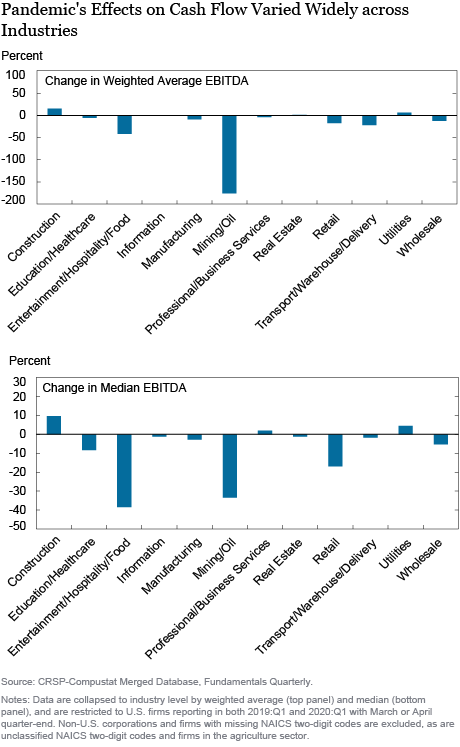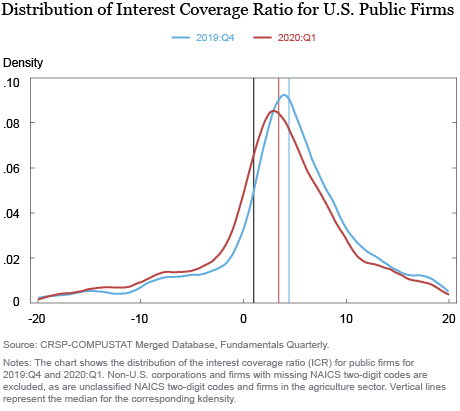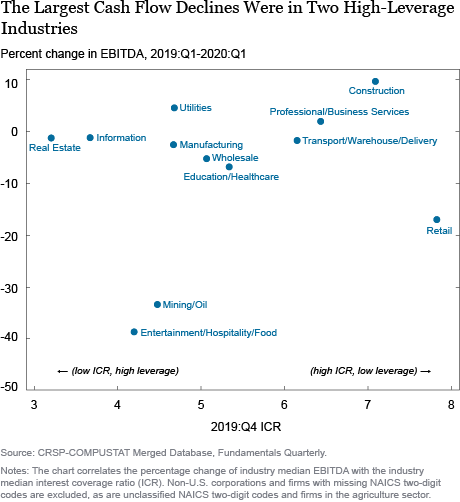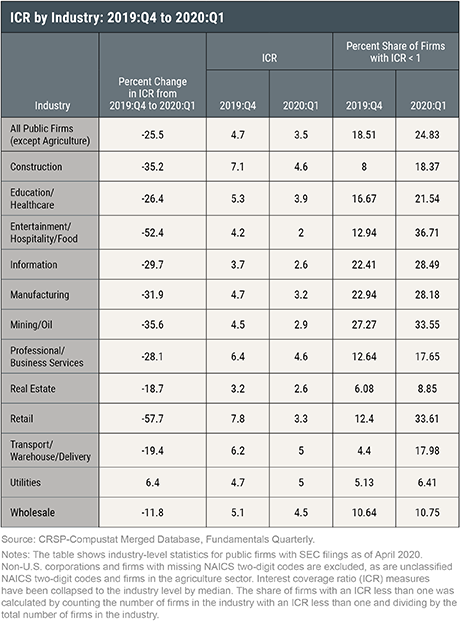Editor’s note: When this post was first published, the table showed incorrect figures for the Professional/Business Services industry; the table has been corrected. (August 10, 10:20 a.m.)
The COVID-19 pandemic has caused significant economic disruptions among U.S. corporations. In this post, we study the preliminary impact of these disruptions on the cash flow and leverage of public U.S. corporations using public filings through April 2020. We find that the pandemic had a negative impact on cash flow while also reducing corporations’ interest expenses. However, the cash flow shock far outpaced the benefits of lower interest payments, especially in industries that were disproportionately levered. Looking ahead, we find that a sizable share of U.S. corporations have interest expense greater than cash flow, raising concerns about the ability of those corporations to endure further liquidity shocks.
Cash-Flow Impact of COVID-19
To study the impact on firm income of the physical distancing and shutdowns necessitated by the COVID-19 pandemic, we look at earnings before interest, taxes, depreciation, and amortization (EBITDA) as a proxy for cash flows. Although EBITDA is not a perfect measure of cash flow since it doesn’t take into account cash necessary for working capital or capital expenditures, using EBITDA allows for better comparison between firms in different industries with differing capital expenditure needs. We calculate the year-over-year percentage change in EBITDA for the universe of U.S. public firms from 2019:Q1 to 2020:Q1 using SEC filings collected in the CRSP-COMPUSTAT database. To capture the impact of the COVID-19 outbreak, we include only firms with SEC filings as of April 2020. We find that the aggregate cash flow for publicly listed firms dropped by around 22 percent from 2019:Q1 to 2020:Q1.
To understand the industry variation in cash flow changes, we compute the weighted average and the median of the percentage change in EBITDA for twelve industries, shown in the two panels below. The impact on cash flow varied widely, with Mining/Oil and Entertainment/Hospitality/Food experiencing the most drastic declines. In Mining/Oil, industry-level EBITDA fell a striking 176 percent (top panel), and the median firm in this industry experienced around a 34 percent decline (bottom panel). For Entertainment/Hospitality/Food, industry-level EBITDA fell by around 41 percent.

In the least affected industries, such as Utilities, the median EBITDA either fell by just a few percent or increased. Note that there was significant heterogeneity within industries. For instance, in retail, auto accessory retailers experienced a large decline in cash flows due to lower use of automobiles by consumers subject to stay-at-home orders, while grocery stores saw increases in their revenues.
How Levered Are Firms in the Most Affected Industries?
During a downturn, highly levered firms are at greater risk of becoming insolvent than their less-levered peers since they must continue to make interest payments on their debt even when their business may have slowed. We use the interest coverage ratio (ICR) as our primary measure of corporate leverage. ICR is calculated by dividing a company’s EBITDA by its interest expense in the same period. If a company’s cash flow is less than its interest expense, it may default on its debt if it is not able to borrow additional money to cover those interest expenses. We define a firm to be at risk of becoming delinquent and its debt being at risk of default (debt-at-risk) whenever its ICR is less than 1. Since the ICR does not account for cash flow needs related to capital expenditures or working capital, even firms with an ICR permanently above but close to 1 may be at risk of becoming delinquent.
The distribution of ICR for public firms in 2019:Q4 and 2020:Q1 is presented in the chart below. Across all firms, the impact of the COVID-19-related fall in income in the Q1 data is relatively mild since U.S. public companies had ample cash flows to cover their expenses, as reflected in the median ICR of almost 4. However, that result marked a decline in the ICR of more than 25 percent from Q4. (These details are also shown in columns 2-4 of the table further down in this post).

This result masks large variation across industries. For each industry, the scatter plot below shows the percentage change in the median EBITDA from 2019:Q1 to 2020:Q1 against the median ICR in 2019:Q4. We find that the fall in EBITDA tends to be especially high in industries with a relatively high ex ante leverage.

With restrictions on travel and restaurant dining in place across the United States, the Entertainment/Hospitality/Food industry has been disproportionately affected by the COVID-19 outbreak. This industry experienced one of the highest increases in the share of firms with ICR below 1, with 36.7 percent of public firms in the sector being at risk of becoming delinquent in 2020:Q1, up from 12.9 percent in 2019:Q4 (shown in columns 5-6 of the table).
Finally, Mining/Oil is another industry characterized by high risk. In 2019:Q4, the share of public firms with ICR less than 1 was around 27 percent. This share increased to more than 33 percent in 2020:Q1, one of the highest among the industries we analyzed. The increase in the share of debt-at-risk can partially be attributed to the sharp decline in oil prices in the beginning of March, which was the result of a global price war as well as falling demand for oil during the pandemic.

What Does the Future Hold?
The first quarter of 2020 includes only one month of pandemic-related disruptions (March), so second-quarter earnings are likely to be worse. Earnings in the remaining quarters of 2020 will depend primarily on the dynamics of the economy which, in turn, depend on the evolution of the pandemic.
Our evidence suggests that there is likely to be wide variation across industries in how the future cash flows of firms are affected by the COVID-19 outbreak. Since the most affected industries during the first quarter were also those with relatively greater leverage before the start of the pandemic, there is heightened concern about the delinquency risk in these sectors.

Anna Kovner is a vice president in the Federal Reserve Bank of New York’s Research and Statistics Group.

Stephan Luck is an economist in the Research and Statistics Group.

Sungmin An is a senior research analyst in the Research and Statistics Group.
How to cite this post:
Anna Kovner, Stephan Luck, and Sungmin An, “Implications of the COVID-19 Disruption for Corporate Leverage,” Federal Reserve Bank of New York Liberty Street Economics, August 10, 2020, https://libertystreeteconomics.newyorkfed.org/2020/08/implications-of-the-covid-19-disruption-for-corporate-leverage.html.











 RSS Feed
RSS Feed Follow Liberty Street Economics
Follow Liberty Street Economics